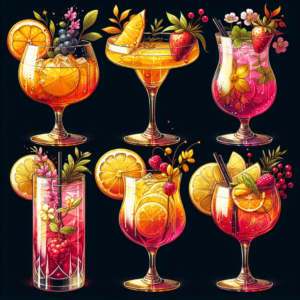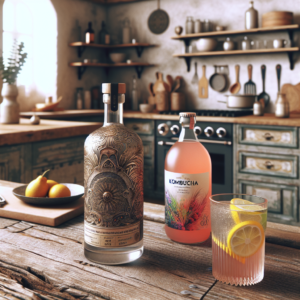
Key Takeaways
Hard kombucha is a fermented tea with a higher alcohol content than traditional kombucha.
The origins of kombucha trace back thousands of years, likely starting in China.
Global brewing methods influence the unique flavors and styles of hard kombucha.
Local ingredients and traditional practices from Asia to South America shape the craft.
Understanding the brewing process and SCOBY’s role is key to appreciating hard kombucha.
Discover the Roots of Hard Kombucha
What Is Hard Kombucha?
Most importantly, let’s define what we’re talking about. Hard kombucha is a fermented beverage that shares its roots with traditional kombucha but is crafted to contain higher levels of alcohol. While regular kombucha typically has an alcohol content less than 0.5%, hard kombucha can range from 4% to 7% alcohol by volume (ABV) or more. This is achieved by adding more sugar and yeast to the fermentation process, which allows for a longer or secondary fermentation period, resulting in a beverage that not only tickles the taste buds but also gives a gentle buzz.
The Origins of Fermented Tea
Kombucha’s story begins thousands of years ago, with its creation often credited to ancient China. It’s believed that this “immortal health elixir” spread through trade routes to Russia and then to the rest of the world. The traditional kombucha is made by fermenting sweetened tea using a symbiotic culture of bacteria and yeast, known as SCOBY. This living mat transforms the tea into a tangy, slightly fizzy drink that’s rich in probiotics.
Brewing Methods That Span Continents
Asian Inspirations: Tea Selection and SCOBY Cultures
Asia, the cradle of kombucha, has a profound influence on the tea selections and SCOBY cultures used in brewing. The type of tea—whether it’s black, green, oolong, or another variety—can significantly affect the flavor profile of the kombucha. The SCOBY, a living organism, also varies from one region to another, imparting distinct characteristics to the brew. Therefore, the choices made at this stage are crucial for the final product.
For example, a kombucha brewed with a Chinese green tea SCOBY will differ in taste and health benefits from one made with a Japanese sencha tea SCOBY. The terroir of the tea—the specific environment where it’s grown, including the soil, climate, and topography—also plays a role in shaping the kombucha’s flavor.
European Adaptations: Fusing Old World Techniques with New Trends
Europeans have taken to hard kombucha with enthusiasm, marrying Old World fermentation techniques with the modern trend of health and wellness. European brewers might incorporate herbs and fruits that are native to their regions, creating hard kombuchas that reflect the local palate and traditions. This fusion of old and new is what makes the European hard kombucha scene so exciting.
North American Innovation: Pushing the Alcohol Content Higher
Then there’s North America, where innovation reigns. Brewers here are not shy about pushing the boundaries, and that includes the alcohol content in kombucha. By tweaking fermentation methods and experimenting with different strains of yeast, they’re crafting hard kombuchas that pack a punch while still delivering on the probiotic promise.
Experiment with yeast strains that can withstand higher alcohol levels.
Utilize secondary fermentation to increase alcohol content.
Incorporate unique flavorings like hops or botanicals for a signature twist.
Besides that, the creativity doesn’t stop with the brewing process. The presentation and marketing of hard kombucha in North America often reflect a youthful, vibrant energy that’s all about lifestyle and enjoyment.
South America’s Twist: Kombucha Infused with Local Flavors
South America brings its zest to the table with kombuchas that are infused with local fruits, spices, and even superfoods like acai and maca. This not only introduces an array of new flavors but also combines the health benefits of these ingredients with those of kombucha.
By embracing the biodiversity of their landscapes, South American brewers create hard kombuchas that are not just beverages, but also a celebration of their rich cultures and natural resources.
Pouring Tradition into Modern Brewing
Case Study: Boochcraft’s Craft Blends
In the sunny climes of California, Boochcraft has been leading the charge in the hard kombucha movement. Their approach marries the healthful aspects of traditional kombucha with a bold flair for innovation. By using high-quality, organic ingredients and a dedicated brewing process, their blends boast a complexity that appeals to both kombucha newcomers and connoisseurs.
Boochcraft products first undergo standard SCOBY fermentation before a special yeast and organic cane sugar are added. “The conditions for that yeast to ferment in are quite unique,” the brewers at Boochcraft explain, showcasing the delicate balance they achieve in their brewing.
This commitment to quality and flavor has allowed Boochcraft to create a lineup that features unexpected flavor combinations, such as grapefruit, hibiscus, and heather, or apple, jasmine, and oak. Their process is a testament to the possibilities that lie in fusing traditional kombucha brewing with modern techniques.
Case Study: Funk Factory Geuzeria’s Hybrid Creations
Meanwhile, in Wisconsin, Funk Factory Geuzeria has carved out a niche by creating hybrid beverages that blur the lines between kombucha and beer. Their unique process involves aging kombucha in oak barrels, which previously held wine or spirits, thus infusing the kombucha with layers of flavor and complexity.
At Funk Factory, the goal is to respect the ancient art of brewing while introducing nuanced flavors. “We’re not just making kombucha; we’re creating a new kind of beverage that honors its roots but isn’t afraid to innovate,” says the founder.
The result is a range of hard kombuchas that resonate with the sour beer crowd, offering tart, complex, and effervescent drinks that challenge and delight the palate.
Case Study: Brekeriet’s Sour Beer Kombucha
Across the Atlantic, Sweden’s Brekeriet takes the fusion concept a step further by combining sour beer brewing techniques with kombucha fermentation. Their Vild series showcases this innovative approach, producing wild ales with a kombucha twist that are both refreshing and rich in heritage.
Brekeriet’s brewers share, “It’s about pushing boundaries while maintaining a deep respect for the fermentation craft. Our Vild series represents a harmonious marriage between the wild yeast’s character and the tangy complexity of kombucha.”
Their creations are not just drinks but stories in a bottle, each sip narrating a tale of tradition and modernity.
The Craft of Flavor: What Makes Hard Kombucha Unique?
Understanding the Flavor Profiles
What sets hard kombucha apart is its distinct flavor profiles, which can range from sweet and fruity to tart and tangy. The combination of tea, SCOBY, and additional ingredients such as fruits or herbs, contribute to a tapestry of tastes that are as varied as they are vibrant.
Sweet and fruity: Often achieved by using teas with natural sweetness and adding fruits like berries or mango during the fermentation process.
Tart and tangy: Typically a result of the natural fermentation process and can be accentuated with citrus or other acidic ingredients.
Herbal and floral: Infusions with botanicals like lavender or rose can create delicate, aromatic profiles.
Earthy and spicy: The use of certain teas or spices like ginger can impart a grounding, warm flavor.
The endless possibilities make hard kombucha a playground for flavor innovation, with each brewer bringing their own signature style to the table.
The Role of SCOBY in Taste Development
The SCOBY is the heart of kombucha brewing. This symbiotic culture is responsible not just for fermenting the tea but also for creating the complex flavors that define kombucha. The SCOBY’s composition can vary, which means that each one can impart different notes to the brew. This variability is what makes kombucha brewing both an art and a science.
During fermentation, the SCOBY consumes the sugars in the tea, producing alcohol, carbon dioxide, and organic acids. These acids, such as acetic, gluconic, and glucuronic acid, contribute to the tartness and depth of flavor in kombucha. Therefore, the SCOBY is not just a fermenter; it’s a flavor creator.
Nurturing a Community of Kombucha Brewers and Enthusiasts
Sharing Brewing Techniques and Recipes
The hard kombucha community is a vibrant and collaborative space where brewers share techniques, recipes, and stories. From homebrew forums to professional brewing conferences, the exchange of knowledge is constant and generous. Many brewers start at home, experimenting with small batches, and as their skills grow, so does their desire to share their discoveries with others.
Whether it’s a recipe that perfectly balances sweetness and tartness or a brewing technique that enhances the effervescence of the drink, the community thrives on shared success and innovation.
Events and Festivals Celebrating Kombucha
Apart from the online world, there are events and festivals dedicated to celebrating kombucha. These gatherings are not just about sampling different flavors but also about learning and connecting. Workshops on brewing techniques, talks on the health benefits of kombucha, and tasting sessions are commonplace, creating an immersive experience for both seasoned aficionados and curious newcomers.
Such events serve as a testament to the growing popularity of hard kombucha and the community’s passion for this fermented marvel.
Future Ferments: The Evolution of Hard Kombucha
Emerging Trends in Hard Kombucha
The hard kombucha market is ripe with innovation. As more people seek out healthier alcohol alternatives, the demand for hard kombucha continues to grow. Emerging trends include the use of exotic teas, local and seasonal ingredients, and even barrel-aging techniques to introduce new dimensions of flavor.
Furthermore, sustainability is becoming a key factor in production, with many brewers committing to organic ingredients, eco-friendly packaging, and responsible sourcing. This aligns with the values of many hard kombucha drinkers who are not just interested in what they consume but also in how it’s produced.
With each new trend, hard kombucha cements its place in the world of fermented beverages, offering a delightful and health-conscious option for those who enjoy a tipple.
Health Benefits: Myth or Reality?
The conversation around hard kombucha often includes a discussion of its health benefits. Some claim that the drink offers everything from improved digestion to boosted immunity. While it’s true that traditional kombucha contains probiotics, enzymes, and acids that can be beneficial for gut health, it’s important to note that the higher alcohol content in hard kombucha may affect these benefits. Research in this area is still emerging, and it’s essential to consume hard kombucha as part of a balanced diet.
That being said, for those looking to enjoy a social drink with potentially fewer negative effects than traditional alcoholic beverages, hard kombucha can be a viable option. Always remember to consume it responsibly, and consider the alcohol content when assessing its place in your health regimen.
Frequently Asked Questions
What differentiates hard kombucha from regular kombucha?
The main difference between hard kombucha and regular kombucha is the alcohol content. Regular kombucha typically contains less than 0.5% alcohol by volume, as a byproduct of the natural fermentation process. Hard kombucha, on the other hand, undergoes an extended fermentation process or a secondary fermentation with additional sugar and yeast, resulting in an alcohol content that can be similar to that of beer or wine, typically between 4% to 7% ABV.
Can hard kombucha be brewed at home?
Yes, hard kombucha can be brewed at home with the right equipment, ingredients, and a bit of patience. The process involves brewing a batch of sweet tea, adding a SCOBY, and allowing it to ferment. To increase the alcohol content, additional sugar and a high-alcohol-tolerance yeast strain are introduced during a secondary fermentation. It’s important to monitor the alcohol levels and to ensure that the brewing environment is clean to prevent contamination.
However, due to the higher alcohol content, homebrewers should be aware of their local homebrew laws, as brewing hard kombucha may be subject to different regulations than brewing non-alcoholic kombucha.
What are the legal regulations surrounding the brewing and sale of hard kombucha?
The brewing and sale of hard kombucha are regulated similarly to other alcoholic beverages. In the United States, for example, hard kombucha brewers must comply with the regulations set forth by the Alcohol and Tobacco Tax and Trade Bureau (TTB), as well as state and local laws. This includes obtaining the necessary permits, paying alcohol taxes, and following labeling requirements. For consumers, the legal drinking age applies to hard kombucha just as it does to other alcoholic drinks.
How do the antioxidants in kombucha affect its health benefits?
Kombucha, including its hard counterpart, is often touted for its antioxidant properties, which come from the tea leaves used in brewing. Antioxidants can help combat oxidative stress in the body, potentially reducing the risk of chronic diseases. However, it’s worth noting that while hard kombucha may contain antioxidants, the overall health impact should be considered in the context of its alcohol content. As with any health claims, moderation is key, and individuals should consult healthcare professionals regarding their dietary choices.
Hard kombucha has gained popularity as a healthier alternative to traditional alcoholic beverages, with different cultures adding their unique twist to the brewing process. For instance, some brewers are experimenting with kombucha margarita recipes that combine the probiotic benefits of kombucha with the classic flavors of a margarita, creating a unique cocktail experience.




Leave a Reply